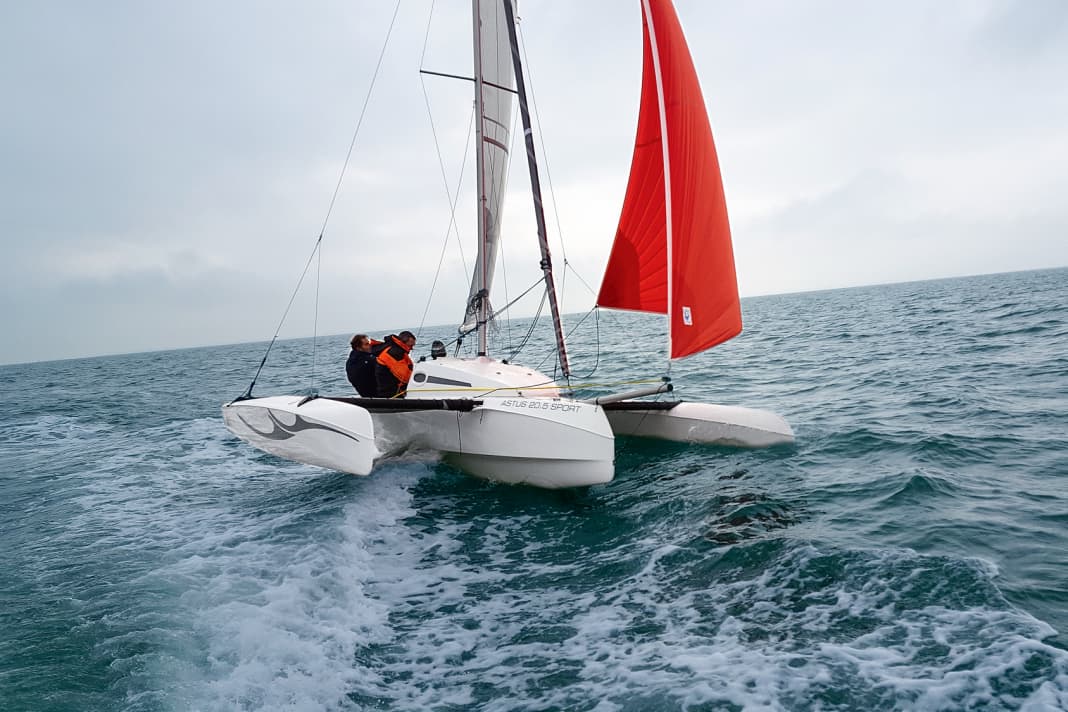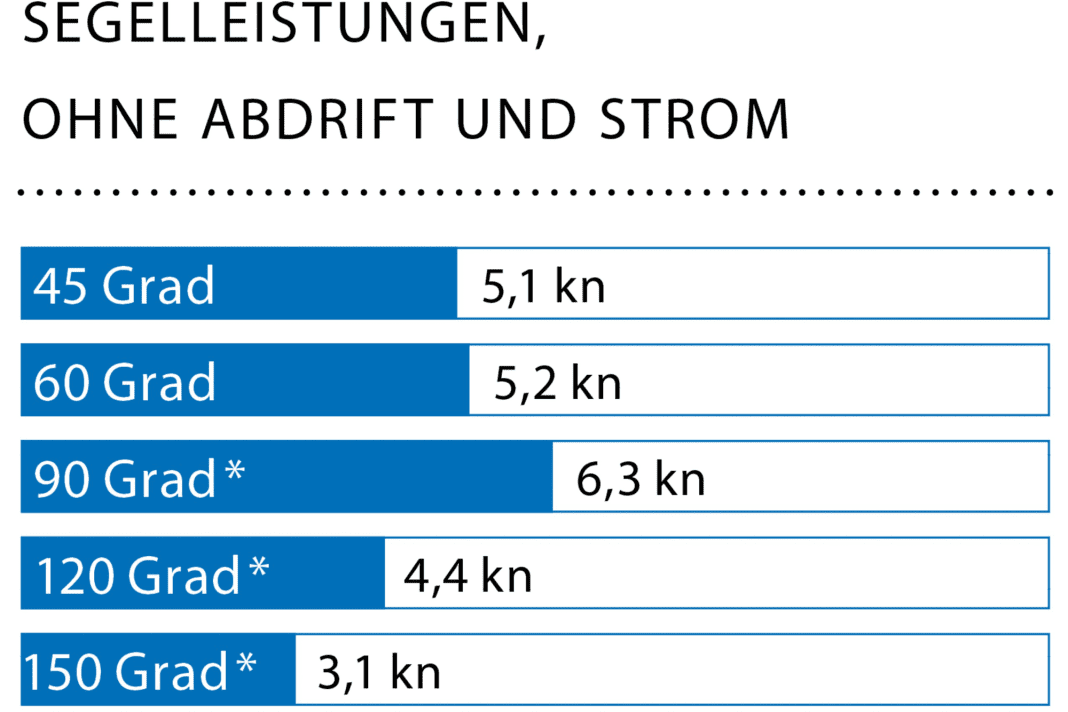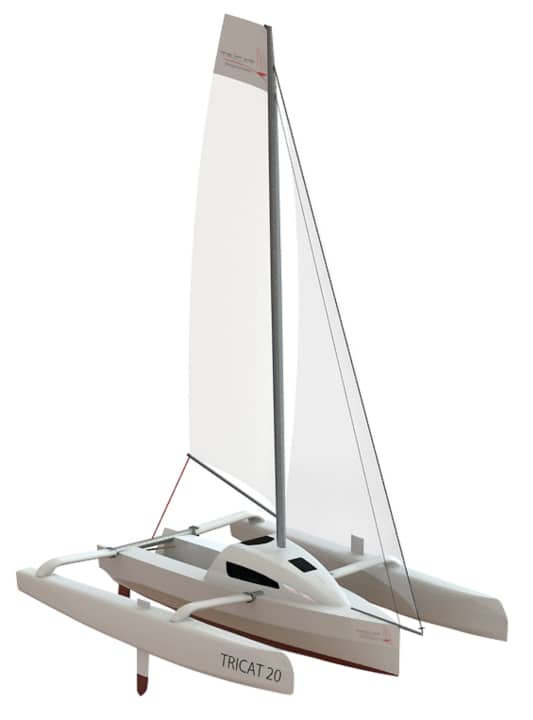Tricat 20: Smart jack-of-all-trades with an eye for the essentials in the test






Baptiste Paquier has been travelling for almost 20 hours, by van and trailer, from Plescop in Brittany, where he works at the Tricat Trimarans shipyard, to Lake Constance for a test with YACHT. He brought along the latest and smallest model of his brand, the Tricat 20, neatly packed and lashed down for transport.
Assembly in no time at all
It takes almost exactly one hour from the moment it arrives in Langenargen harbour until the subject is launched via the slipway, including untying, setting the mast and hoisting the sail. The optional jib device with a strong bulkhead buoy helps with rigging, which two people can do easily and without much effort. If you wish, you can also add lateral shroud guides so that you can also manage mast hoisting alone.
The launching itself is just as easy. The road trailer offered by the boatyard can be folded using hinges. This means that the Tri can even be launched over a shallow ramp without the towing vehicle having to drive very far into the lake.
Triple is better: the competition for the Tricat 20



Astus 20.5
- Designer: VPLP Design
- Torso length: 5,95 m
- Waterline length: 5,90 m
- Width: 4,50-2,48 m
- Depth: 1,25-0,30 m
- Weight: 450 kg
- sail area: 20,0 m2
- Sail carrying capacity: 5,8
Corsair Pulse 600
- Designer: François Perus
- Hull length: 6.00 m
- Waterline length: 5.96 m
- Width: 4.50-2.45 m
- Draught: 1.20-0.22 m
- Weight: 450 kg
- Sail area: 26.6 m2
- Sail carrying capacity: 6.7
Unfortunately, there is not much wind at Lake Constance for testing the Tricat 20. However, some thermals of a maximum of 6 knots are enough to have a lot of fun with the small tripod. The boat accelerates immediately and shows agile responsiveness despite having three hulls. At an angle of around 45 degrees to the wind, the little Frenchman reaches a speed of 5.1 knots, which is quite a lot for the conditions. We would have loved to put the Tricat 20 to the test in stronger winds, which promises a lot of sporty sailing fun.
However, it must be mentioned that the test boat, construction number 4 from the current series, is equipped with a significantly higher carbon fibre rig and better laminate sails. A performance package bundles all the special equipment to increase performance with a total of 3.5 square metres more sail area. The gennaker and a retractable bowsprit are also available to customers on request. As standard, the Tricat 20 is delivered from the shipyard with an aluminium mast and a simple set of Dacron sails.
Rigid connections
An important issue with trailerable trimarans are the movable side hulls and the mechanism for reducing the width. The manufacturers tackle this task in very different ways. With Tricat, the floats are swivelled backwards until they are close to the hull. This allows the width of 4.50 metres to be reduced quickly and easily to a roadworthy 2.40 metres. The side hulls are extended for sailing via a sheet hoist, but this only works in practice if the crew on board lend a helping hand with their arms and legs. In addition, the winch mounted on the side deck is too small and too weak. A powerful tackle hoist would do a better job here.
Tricat's boats are built entirely in the Breton shipyard, including the larger 25 Evolution and the flagship 30 (test in YACHT 8/2018). The hulls and decks are produced using a vacuum infusion process with a foam core and polyester resin.
As a special feature of the Tricat concept, the carbon fibre centreboards are located in the side hulls, but on the small Tricat 20 they have an unacceptable amount of play there, which is unpleasantly noticeable when sailing with a constant clacking noise; the shipyard still needs to make improvements to the profile guides. The pivoting beams are also made of carbon and are reinforced inside with aluminium square profiles. The connections between the hulls are rigid and the mechanism for swivelling is technically quite sophisticated.
Also for the weekend
The high cabin superstructure on the centre hull, which is almost oversized for the small boat, is striking and perhaps not necessarily visually appealing. The advantage: two people can not only sleep comfortably below deck on the short tour, but also sit upright and relaxed inside. A small, practical kitchen module with gas cooker and storage space for provisions is available as an option.
The new Tricat 20 is another small, exciting and versatile trimaran that can be used as a daysailer or weekender. The boat can do what it is supposed to do - and even a bit more. There is an extra portion of sailing fun on top.
The measured values for testing the Tricat 20




The Tricat 20 in detail

Technical data of the Tricat 20
- Designer: A. Houdet
- CE design category: C
- Torso length: 5,99 m
- Width: 4,50-2,40 m
- Depth: 1,10-0,30 m
- Weight: 580 kg
- Mainsail: 16,5 m2
- Fock: 9,0 m2
- Motorisation: Outboard/electric
Hull and deck construction
GRP sandwich construction, built using the vacuum infusion process. Rudder, centreboards and beams made of carbon fibre
Price and shipyard
- Base price ex shipyard: 46,060 € (basic version)/ 49,995 € (Family version)/ 54,740 €(Croisière version). All prices gross, including 19% VAT. (as at 04/2024)
- Guarantee/against osmosis: 2/2 years
Shipyard
Tricat, 56890 Plescop (France); www.trimaran-tricat.com
YACHT rating of the Tricat 20
Sophisticated and habitable small Tri from France for a wide range of uses. In the light wind test, the test boat, optionally equipped with the performance package, showed a lot of potential
Design and concept
- + Versatile orientation
- + Slip cabin with large berth
Sailing performance and trim
- + Moves quickly and easily
- + Simple handling
Living and finishing quality
- + Pantryblock as an option
- - Partially unclean processing
Equipment and technology
- + Many and large storage spaces on deck
- - Swivelling only with coaching
- - Inappropriate guidance of the swords
The article first appeared in YACHT 01/2020 and has been updated for the online version.

